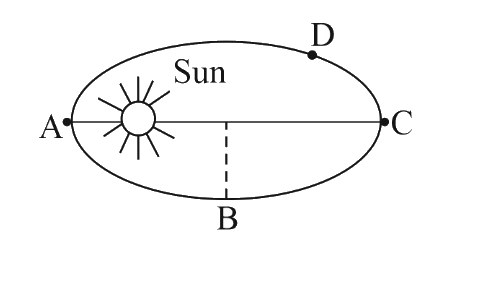Assertion(A) : The earth revolves around the sun an elliptical orbit
Reasoning(R) : The sun alwaye attracts the earth with the same force
both Assertion and Reason are both are both wrong
Assertion is right, Reason is wrong
both Assertion and Reason are correct and Reason explains Assertion
both Assertion and Reason are correct, but Reason does not explain Assertion
The correct Answer is:C
To solve the question, we need to evaluate the assertion and reasoning provided:
Assertion (A): The earth revolves around the sun in an elliptical orbit.
Reasoning (R): The sun always attracts the earth with the same force.
1. Understanding the Assertion (A):
- According to Kepler's laws of planetary motion, specifically the first law, planets (including Earth) move in elliptical orbits with the Sun at one of the foci.
- This statement is true.
2. Understanding the Reasoning (R):
- The gravitational force between two bodies (such as the Earth and the Sun) is given by Newton's law of gravitation:
F=G⋅m1⋅m2r2
where F is the gravitational force, G is the gravitational constant, m1 and m2 are the masses of the two bodies, and r is the distance between their centers.
- As the Earth moves in its elliptical orbit, the distance r between the Earth and the Sun changes. Therefore, the gravitational force acting on the Earth by the Sun also changes as the distance changes.
- This means that the statement "the sun always attracts the earth with the same force" is incorrect.
3. Conclusion:
- Since the assertion is true and the reasoning is false, we conclude that the correct answer is that the assertion is true, but the reasoning is false.
Final Answer:
- Assertion (A) is true.
- Reasoning (R) is false.
- Therefore, the correct option is that Assertion is true and Reasoning is false.
---
Reasoning (R): The sun always attracts the earth with the same force.
- According to Kepler's laws of planetary motion, specifically the first law, planets (including Earth) move in elliptical orbits with the Sun at one of the foci.
- This statement is true.
- The gravitational force between two bodies (such as the Earth and the Sun) is given by Newton's law of gravitation:
F=G⋅m1⋅m2r2
where F is the gravitational force, G is the gravitational constant, m1 and m2 are the masses of the two bodies, and r is the distance between their centers.
- As the Earth moves in its elliptical orbit, the distance r between the Earth and the Sun changes. Therefore, the gravitational force acting on the Earth by the Sun also changes as the distance changes.
- This means that the statement "the sun always attracts the earth with the same force" is incorrect.
- Since the assertion is true and the reasoning is false, we conclude that the correct answer is that the assertion is true, but the reasoning is false.
- Assertion (A) is true.
- Reasoning (R) is false.
- Therefore, the correct option is that Assertion is true and Reasoning is false.
Similar Questions
Knowledge Check
The earth moves around the Sun in an elliptical orbit as shown in Fig. The ratio OA/OB=x. The ratio of the speed of the earth at B to that at A is nearly
 A√xBxCx√xDx2
A√xBxCx√xDx2A planet revolves around the sun in an elliptical orbit. Suppose that the gravitational attraction between the sun and the planet suddenly disappear then the planet would move
Atowards the sun in a spiral pathBaway from the sun along a straight path with continuously increasing speedCwith constant speed along a tangential path to the oribtDtowards the sun along a straight path with constant speedA planet revolves around the sun in an elliptical orbit. If vp and va are the velocities of the planet at the perigee and apogee respectively, then the eccentricity of the elliptical orbit is given by :
AvpvaBva−vpva+vpCvp+vavp−vaDvp−vavp+va
Earth completes one orbit around the sun is
View SolutionThe earth revolves round the sun because the sun attracts the erth. The sun also attracts the moon and this force is about twice as large as the attraction of the earth on the mon. Why does the moon not revolve round the sun? Or does it?
View SolutionA planet revolves around the sun in an elliptical . The linear speed of the planet will be maximum at

View SolutionIn adjoining figure earth goes around the sun in eliptical orbit on which point the orbital speed is maximum :

View SolutionA planet revolves around the sun in elliptical orbit of eccentricity 'e'. If 'T' is the time period of the planet then the time spent by the planet between the ends of the minor axis and major axis close to the sun is
View Solution
